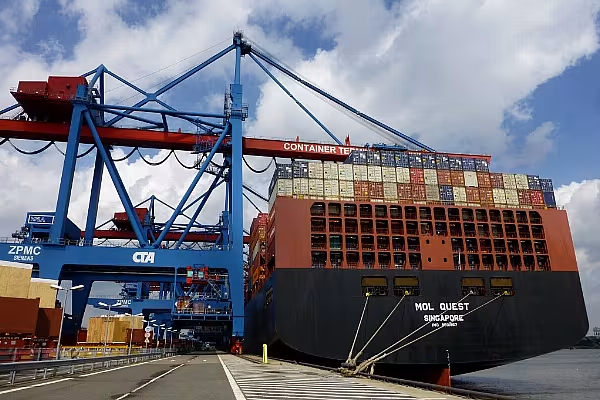China sought to stabilise the deteriorating trade relationship with the US, as the prospect of an investigation by the Trump administration on intellectual property raised the risk of tit-for-tat measures from Beijing.
US officials are gearing up to investigate China over what the administration perceives to be violations of intellectual property - a charge Beijing rebuffed Thursday. Ministry of Commerce spokesman Gao Feng said that China pays "high attention" to intellectual property and wants to maintain good cooperation with the US.
Still, China has for some time had countervailing measures at the ready in case a trade conflict erupts, and has singled out soybean imports as a lever to exert influence should the US take action, according to people familiar with the matter.
In the meantime, state media have also signaled the nation would hit back against any trade measures, as it has done in past episodes. This time around, the need to project strength domestically is compounded by the looming twice-a-decade leadership reshuffle that may further entrench President Xi Jinping’s power.
"Ahead of the 19th Party Congress, the last thing that China will want is a trade war," said Callum Henderson, a managing director for Asia-Pacific at Eurasia Group in Singapore. "It is also important that Beijing does not look weak in this context. As such, expect a cautious, proportional response."
Section 301
The administration is considering having the US Trade Representative’s office investigate under section 301 of the Trade Act of 1974, the New York Times reported. The provision allows the president to impose tariffs to protect U.S. industry from foreign countries’ unfair trading practices.
If the US launches the probe, it will be the latest of several the administration is conducting that could impact trade ties between the world’s two biggest economies. The Commerce Department is examining whether steel imports from China and other foreign producers threaten national security under another seldom-used legal provision, section 232 of the 1962 Trade Expansion Act.
After sending warm signals toward China early in his presidency, Trump appears to be dialing up pressure on the Chinese government to change its ways. At the same time, he has been reluctant to pull the trigger on steep import tariffs or quotas that would risk retaliation. Trump recently backed away from threats to slap tariffs on foreign steel, after he took heat from Group of 20 nations and US businesses that said the move would raise costs.
The question is whether US officials are willing to risk a trade war as they up the ante. The International Monetary Fund warned last month that “inward-looking” policies could derail a global recovery that has so far been resilient to raising tensions over trade.
China has a long history of tit-for-tat retaliation against trade actions. There’s no reason to believe it would be any different this time, said Kenneth Jarrett, President of the American Chamber of Commerce in Shanghai.
"This reality should be part of Washington’s calculations as it considers options," he said.
Soybeans Stemmed
The two countries have signed a modest roster of deals over the past several months that are aimed at reducing the trade surplus that China runs - like that for the import of 12.5 million tonnes of US soybeans in July.
Still, Chinese officials have mulled stemming US imports should retaliation be necessary. Under a draft plan, soybeans have been singled out as the top product that can be dialled back, according to people familiar with the matter. Autos, aircraft and rare-earth commodities have also been identified as potential categories for restriction, the people said.
Soybeans for November delivery on the Chicago Board of Trade dropped as much as 1.2% to $9.655 a bushel. The oilseed for September delivery on the Dalian Commodity Exchange fell as much as 0.6% to 3,771 yuan a metric tonne.
Trump has also reneged on threats, such as his campaign pledge to brand the nation a currency manipulator. He’s said the reason he stood down from using that tag was because of a promise of cooperation from Chinese officials to help rein in North Korea. With the regime in Pyongyang conducting the second inter-continental ballistic missile test in a month last week, the pressure to act may be rising.
“So far, it’s all been posturing, with little action,”’ said Scott Kennedy, a US-China expert at the Centre for Strategic and International Studies in Washington. “Pressure is building to do something, so the US doesn’t look like a complete paper tiger.”
Trade Sledgehammer
The US sometimes uses section 301 to launch trade complaints against other countries through the World Trade Organisation. But the law also gives the administration broad authority to levy punitive tariffs without going to the WTO, said Warren Maruyama, a former USTR general counsel and trade partner at Hogan Lovells in Washington.
The US has seldom used that part of the law since the 1990s. China could likely challenge any action at the WTO and would probably win, but it may not bother with legal niceties and instead find a way to simply retaliate in kind, just as it has done in the past, Maruyama said.
“It’s a sledgehammer,” he said. “301 was the big trade weapon for the United States during much of the 1980s and into the early 1990s.”
Any US tariff hikes on China that fall foul of WTO rules or go around the system could unleash retaliation, Michael Froman, a US Trade Representative from the Obama administration, said in an interview with Bloomberg TV. China’s Commerce Ministry on Thursday warned against procedures outside the WTO framework.
If the US moves away from resolving trade disputes through the WTO and instead starts taking unilateral action, “it will just lead other countries to retaliate against us or, perhaps even worse, imitate us, and take action on their own without regard to international obligations,” Froman said.
News by Bloomberg, edited by ESM. Click subscribe to sign up to ESM: The European Supermarket Magazine.














